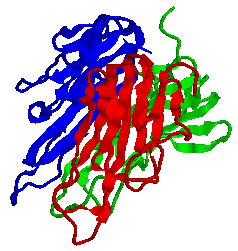It:Tumor Necrosis Factor
Tumour Necrosis Factor

Tumor necrosis factor is a family of proteins, the most common of which is tumor necrosis factor alpha. All these proteins are cytokines and contain 157 amino acid 'links' in the protein 'chain', with each molecule containing three protein chains joined together. This trimeric structure is important as the initial funtion of tumor necrosis factor is to bring three receptor proteins on specific cells together. This initiates a cascade of signals within the cell. Tumour necrosis factor alpha is a molecule that causes a local response to an infection by causing pain or redness and fever, and also causes necrosis (death) in tumors. It is one of the body's best weapons against foreign invaders and cancer, but in large amounts can be dangerous. It has a number of actions on various organ systems, generally together with interleukins 1 and 6:

On the hypothalamus: Stimulates the hypothalamic-pituitary-adrenal axis by stimulating the release of corticotropin releasing hormone (CRH). Suppresses appetite (hence its name "cachexin" - cachexia is severe weight loss in illness). Fever.
On the liver: stimulates the acute phase response, leading to an increase in C-reactive protein and a number of other mediators. It also attracts neutrophils very potently, and helps them to stick to the endothelial cells for migration.
On macrophages: stimulates phagocytosis, and production of IL-1 oxidants and the inflammatory lipid prostaglandin E2 (PGE2).
On other tissues: increases insulin resistance.
A locally increasing concentration of TNFα will cause the cardinal signs of Inflammation to occur: Heat, swelling, redness and pain.
Pharmacology
This molecule is the root cause of the symptoms of many diseases, including psoriasis, Crohn's disease, ankylosing spondylitis, rheumatoid arthritis and refractory asthma. These symptoms can sometimes be treated with a monoclonal antibody, and research is active in this area.
TNF or the effects of TNF are also inhibited by a number of natural compounds, including curcumin (2,3,4,5) (an ingredient in turmeric) and catechins (in green tea).
However, in other cases in medicine it is not the reduction of amounts of TNF released that is desired. When treating cancer patients, we would like to be able to enhance the necrotic effect of TNF on tumours. It has been demonstrated that soluble TNF will attack tumours in quite a dramatic way, but unfortunately TNF is far too toxic to be directly administered as a systemic drug.
Mind body medicine
Recent discoveries show that the brain limits the amount of TNF released directly, by sending electrical messages via the vagus nerve and blocking the release of the chemical from specific sites on immune cells. This is one of the only examples where the brain is able to directly control otherwise instinctive chemical responses to infections, and so studies have also been done to see if the control of this chemical presents a way to 'think yourself better'. This mind-body connection may even provide an explanation as to why indo-tibetan monks live longer than expected, even when their diet, living conditions and lifestyle are factored in to the equation. It is possible that the yogic and meditative traditions of buddhist and hindu monks is stimulating vagus nerve activity and limiting the excessive release of damaging necrosis factor, which may reduce life expectancy by destroying cells, increasing 'cell turnover'. The 14th Dalai Lama, Tenzin Gyatso, recently permitted research to be carried out concerning Tibetan monks; he also spoke at a conference, "Longevity and Optimal Health: Integrating Eastern and Western Perspectives", which was co-hosted by Columbia University Integrative Medicine Program and Tibet House.
